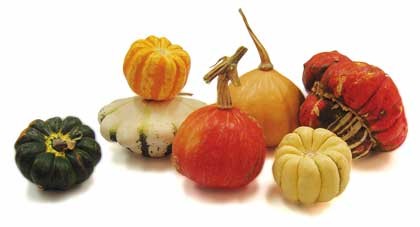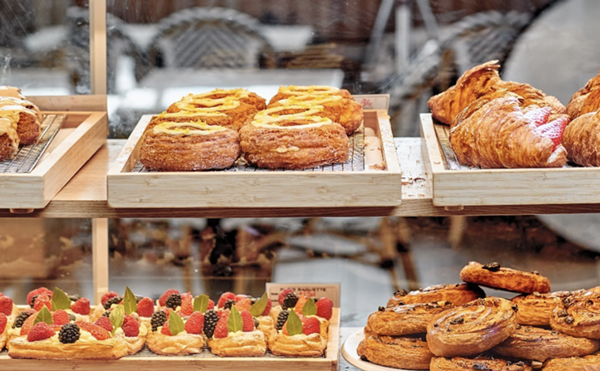Winter squash tastes as festive as it looks, and it's a mighty source of antioxidants
In South Texas, autumn is the most ambivalent of seasons - and the most pleasant. In other parts of the country, the leaves are at their brilliant peak, golden and red; here in San Antonio, the live oaks are resolutely green. It's not 100 degrees, but neither is it 50, and while the days are shorter and the light is crisper, it feels more like Indian summer than fall. That's not a complaint - I'm thankful for long walks in the temperate air - but the mono-season makes it all the more fun to pick through the piles of sunny orange, variegated green and yellow, and flaming-red winter squash at the market.
| A harvest of winter squash, from left: Acorn, sweet dumpling, green-stripe scallop, red curry, golden marble, carnival, and turban. |
Unlike our seasons, the distinction between the summer squash and winter squash is not so subtle. While all squash belong to genus cucurbita, there are quite a few species: For example, acorn and spaghetti squash, and pumpkins belong to the cucurbita pepo family, which also includes cucumbers, gourds, and summer squash, such as yellow crookneck and patty pan; butternut belongs to the c. moschata, and hubbard, turban, and kabocha to c. maxima. Gardeners may sweat the species, but for home cooks the difference between summer and winter squash is simply that the former is eaten when the fruit is immature and the skin is tender, and the latter only after a hard rind has formed and the flesh is sweet and dark.
Choosing a winter squash is difficult; it's tempting to bring home a few of each and, when they overrun the kitchen, scatter them across the dining-room table and the porch. But, in terms of good eating, look for one that is heavy for its size, hard-skinned - you should not easily be able to pierce it with a fingernail - with no bruises or cuts, and a dull finish. (If it's glossy, it may have been plucked from the vine too young, or it's covered in wax.) Because of their hard shells, whole winter squash can be stored outside the refrigerator, and will last up six months if kept in a cool, dry place. Once cut, winter squash lasts no more than a few days.
In recipes, most winter squash are interchangeable, but they do have their differences: Nutty acorn has a sweet, peppery flavor when roasted, and makes a buttery puree that can be eaten straight with sweet or savory spices or whisked into soups; warty hubbard's mildly sweet, yellow flesh is as good as pumpkin in pie; and half of a moist, sweet dumpling, at about 4 inches across, makes a perfect single-serving cup for stuffing with sausage and vegetables.
The novelty of spaghetti squash is always a revelation. While it doesn't work well in ravioli or soup, roasted or baked its bright yellow flesh separates into long, bland strands that stick to a marinara sauce as well as any fettuccine.
Yet, like all winter squash, spaghetti squash has tenfold the nutritional value of fettuccine. Winter squash is an excellent source of vitamin A - in the form of beta-carotene, an antioxidant - as well as vitamin C, potassium, manganese, and omega-3 fatty acids.
Even the squash blossom is high in vitamin A. I've read that you can pickle squash blossoms, which taste like zucchini, but I haven't been able to locate a single recipe (if you have one, please send it in). There are, however, many recipes for fried squash blossom: Stuff the flower with cheese, dip it in a light batter, and deep-fry it.
Pumpkin seeds are the most famous winter-squash by-product, but did you know acorn squash seeds are also edible? Pumpkin seeds are high in iron, phosphorous, magnesium, manganese, and sleep-inducing tryptophan. To toast either seeds, toss them with a light coating of oil, salt to taste, and bake at 325 degrees until golden and crisp, about 15 minutes.
The versatility of the winter squash is attractive, but the sheer size of some variety can be a little intimidating. I recently brought home a stunning 10-pound turban squash under the pretense of cooking it. However, when the reality hit me that it might produce 240 ravioli, I stuck it next to the clock on the mantelpiece. There, its brilliant orange topknot serves as constant reminder that, even if my sweaters are still in the attic, it's fall in San Antonio. •
By Susan Pagani


















